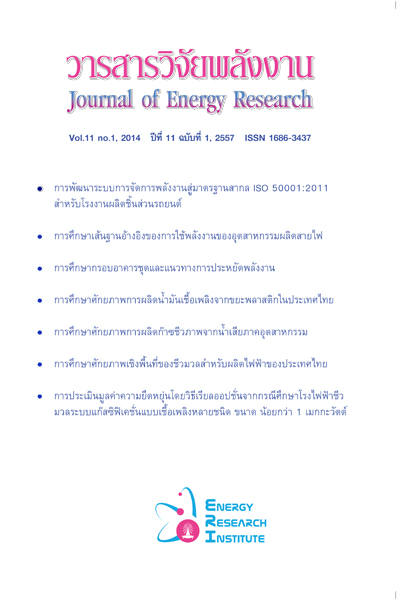การพัฒนาระบบการจัดการพลังงานสู่มาตรฐานสากล ISO 50001:2011 สำหรับโรงงานผลิตชิ้นส่วนรถยนต์
Main Article Content
Abstract
งานวิจัยนี้มีวัตถุประสงค์เพื่อพัฒนาระบบการจัดการพลังงานตามพระราชบัญญัติการส่งเสริมการอนุรักษ์พลังงาน พ.ศ. 2535 (แก้ไขเพิ่มเติม พ.ศ. 2550) ไปสู่มาตรฐานสากล ISO 50001:2011 กรณีศึกษา บริษัท ผลิตชิ้นส่วนรถยนต์ ซึ่งเข้าข่ายเป็นโรงงานควบคุม โดยการเปรียบเทียบขั้นตอนการจัดการพลังงานตามกฎหมาย 8 ขั้นตอน กับข้อกำหนด ISO 50001:2011 พบว่า มีความคล้ายคลึงกันอย่างมากเนื่องจากทั้ง 2 ระบบใช้พื้นฐานการทำงานแบบ การวางแผน – การปฏิบัติ – การตรวจ – การแก้ไขและปรับปรุง (Plan – Do – Check – Act) หรือ PDCA สิ่งที่แตกต่างกันมีเพียงรายละเอียดบางประการที่จะต้องปฏิบัติเพื่อให้เป็นไปตามข้อกำหนด โดยรวมแล้วระบบการจัดการพลังงาน ISO 50001:2011 มีเนื้อหาและข้อกำหนดมากกว่า แต่ก็มีความยืดหยุ่นมากกว่าด้วย โดยหัวข้อหลักที่ควรให้ความสำคัญก็คือ การบ่งชี้พื้นที่ที่มีประเด็นการใช้และปริมาณการใช้พลังงานที่มีนัยสำคัญ การกำหนดวัตถุประสงค์เป้าหมายการอนุรักษ์พลังงาน ซึ่งในที่นี้ได้ใช้เทคนิคการควบคุมกระบวนการเชิงสถิติ (Statistical Process Control หรือ SPC) เป็นเครื่องมือ การกำหนดมาตรการอนุรักษ์พลังงาน การตรวจติดตามและการทบทวนระบบการจัดการพลังงาน
ENERGY MANAGEMENT SYSTEM DEVELOPMENT FOR ISO 50001:2011 FOR AUTOMOTIVE PARTS FACTORIES
The objective of this research is to investigate a procedure to improve the existing energy management system based on The Energy Conservation Promotion Act B.E. 2535 (1992) (as amended by Energy Conservation Promotion Act (No.2) B.E. 2550 (2007)) to meet the requirements of the internationally recognized ISO 50001:2011. The case study here is an automotive parts manufacturing company, which is considered a designated factory under the aforementioned law. The 8-step energy management system according to the law was compared with the system that meets the ISO 50001:2011 requirements. It was found that both energy management systems share a lot of similarities as they both apply the Plan-Do-Check-Action (PDCA) procedure in their basic functions on the Deming cycle. Slight differences between the two systems lay in the details of the procedure which are to be adjusted to meet the ISO 50001:2011 requirements, which include more detailed specifications yet allow for higher flexibility. The areas that deserve great emphasis are the identification of the areas of significant energy use, the setting of energy saving targets through Statistical Process Control (SPC), the energy saving measures to be taken and energy management system monitoring and review.

